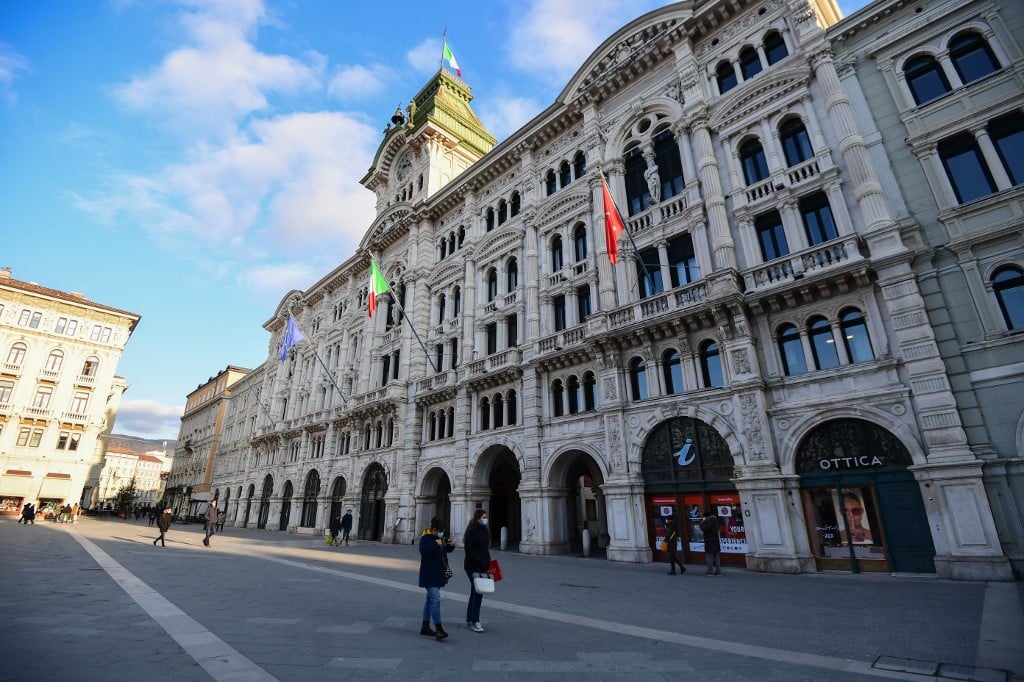An expert guide to getting Italian citizenship via ancestry

Applying to have your Italian birthright citizenship recognised can be dizzyingly complicated, so we asked Italian legal specialists to share their advice on the process.
In theory, applying for Italian 'birthright' citizenship via ancestry - jure sanguinis or ius sanguinis - should be straightforward.
Unlike citizenship through residency or marriage, your application isn't subject to language requirements or other administrative hurdles, as you're essentially applying to have an existing right recognised.
And you can go back a number of generations - all the way back to the founding of the Kingdom of Italy in March 1861, if you can unearth all the required documents.
In reality, however, proving you're a direct descendent of someone who's often long dead and who you may only know through a few grainy black and white photographs and family lore can be a long and convoluted process.
Where to start
There are three routes to applying for jure sanguinis Italian citizenship (though applicants have limited choice over which they can use). These are:
- Through your nearest Italian consulate
- Through the Italian courts
- By taking up residency in Italy and applying at your local town hall.
In most cases, people outside Italy will apply to their nearest Italian consulate.
You can only apply directly through the Italian courts if you have a '1948 Rule' case - i.e., if you're applying via a female ancestor born before 1948 (in this case, you have to apply through the courts).
READ ALSO: How the '1948 rule' could affect your Italian citizenship application
However, because there are now major delays with booking an appointment at most Italian consulates, you can appeal to have an Italian judge review your case. Bear in mind you'll need proof that you tried to go through the consulate first.
While going through the courts can speed things up, it's not necessarily a silver bullet. You must apply to the immigration court closest to the town or city where you ancestor was from, and some of these are facing their own backlogs.
READ ALSO: 'Next to impossible': How backlogs are delaying applications for Italian citizenship
Arturo Grasso, a managing partner of the Rome-based law firm My Lawyer in Italy who specialises in Italian citizenship, says he knows of one applicant who was recently given a three-year wait for their hearing at the court in Brescia.

Photo by Fallon Travels on Unsplash
In situations like this, Grasso says he asks his clients whether they have other Italian ancestors they could apply through, hailing from towns near courts with shorter wait times.
Applying within Italy as a resident, meanwhile, can often be the fastest route. But it comes with its own complications - more on this option below.
What you'll need
Aleksandra Broom, an immigration and citizenship lawyer at the Rome-based firm Oliver & Partners, says that for applications via the consulate or tribunal, you'll need birth, marriage and death certificates going all the way back to the original ancestor in the genealogical line (including your own, where applicable).
Grasso says that in his experience, some consulates also request the birth and death certificates of each spouse in the family line, while the courts often only ask for birth and marriage certificates. You should be able to find your consulate's specific requirements by checking its website.
Then, you'll need to apply for a 'Certificate of Non-Naturalisation' or 'Certificate of Non-Existence' proving that the ancestor through whom you're applying didn't forfeit their Italian citizenship - or at least, not before passing it on to their children.
READ ALSO: What are the benefits of having Italian citizenship vs residency?
Of course, many emigrants did naturalise upon leaving Italy - but you're still applying for a Certificate of Non-Naturalisation in the first instance, Broom says. If your ancestor had multiple name variations over the years, she notes, you'll need to supply all of these to the relevant archival authorities.
If a records search turns up nothing for any of these names and you do receive this certificate, Grasso describes it as a "golden ticket" when it comes to applying through the Italian courts - though he says consulates sometimes demand additional proof in the form of census records.
If, on the other hand, records show that your ancestor did naturalise and renounce their Italian citizenship, you'll need to provide their Naturalisation Certificate.
In theory, as long as the date on this certificate shows that your ancestor didn't naturalise as a foreign citizen until after their child was born, there should be no issues with your citizenship application (in reality, Grasso says, things are sometimes more complicated if you're going through the courts).
READ ALSO: What a law from 1912 means for your claim for Italian citizenship via ancestry
All of these documents must then be apostilled to certify their authenticity, and most, if not all, will need to be accompanied by sworn translations. You'll also sometimes be asked to provide additional documentation if there are discrepancies with names or dates.

You'll need to gather a number of documents in order to apply for Italian citizenship by ancestry. Photo by Romain Dancre on Unsplash
Where to find the documents
Broom and Grasso both agree that you should start by locating your Italian ancestor's birth certificate, as it forms the entire basis of your application - and the only place you'll find it is in the comune, or town hall, where they were born.
"There's no other place that you can get it," says Grasso. "It's there in their archives, somewhere in a basement, in books."
If you have problems tracking down the birth certificate - because it's been lost or destroyed in a fire, for example - you should be able to use your ancestor's baptismal certificate, found in local church archives.
READ ALSO: Five surprising Italian citizenship rules you should know about
Of course, some applicants don't know their ancestor's birth date or town of origin, and have little more to go on than a name and region.
In that case, Grasso says he refers his clients to local genealogists like Francesco Curione, who's built a career helping people locate the hard-to-find birth records of their Italian ancestors.
For the Certificate of Non-Existence, meanwhile, you'll need to apply to the relevant authorities in the country/ies your ancestor moved to from Italy.
For the US, that's the United States Citizenship and Immigration Services (USCIS); in the UK, it's the National Archives.
Claiming by going in person to Italy
If you want to speed things up, you can move to Italy, take up Italian residence, and apply for citizenship at your local comune, or town hall.
Importantly, says Grasso, you don't need to move to the town that your ancestor was from; any Italian comune can process your citizenship application.
READ ALSO: How foreigners can get ‘fast track’ citizenship in Italy
That doesn't mean it doesn't matter where you register your residency, though. Local officials in major cities like Rome and Florence are often overwhelmed, and processing times will be much longer there than elsewhere.

The town hall in Trieste, northern Italy. Applying at your town hall can sometimes be the fastest route to Italian citizenship. Photo by MIGUEL MEDINA / AFP.
Conversely, some smaller comuni are working under less pressurised conditions and/or are particularly experienced with citizenship applications, which can accelerate the timeline.
That said, even in the best-case scenario you're still looking at an average wait time of at least six months, Grasso says, during which time you must be continuously resident in Italy.
READ ALSO: Will Italian citizenship mean I have to pay tax in Italy?
If you choose this option, you'll want to to make sure you gather all your citizenship documentation before you arrive in Italy, as you'll need it to apply for your permesso di soggiorno in attesa di cittadinanza (residency permit pending the acquisition of citizenship).
If you come to Italy via another Schengen country, you have just eight days to apply for this permit at the local police headquarters, or questura, Grasso says - whereas if you come from outside the Schengen zone, you have up to 90 days.
Applying at the comune requires that you have the time and resources to relocate to Italy for at least six months, and often longer - making it a less-than-realistic option for the majority of applicants.
Please note that The Local is unable to advise on individual applications for Italian citizenship.
Read more in The Local's Italian citizenship section.
Comments
See Also
In theory, applying for Italian 'birthright' citizenship via ancestry - jure sanguinis or ius sanguinis - should be straightforward.
Unlike citizenship through residency or marriage, your application isn't subject to language requirements or other administrative hurdles, as you're essentially applying to have an existing right recognised.
And you can go back a number of generations - all the way back to the founding of the Kingdom of Italy in March 1861, if you can unearth all the required documents.
In reality, however, proving you're a direct descendent of someone who's often long dead and who you may only know through a few grainy black and white photographs and family lore can be a long and convoluted process.
Where to start
There are three routes to applying for jure sanguinis Italian citizenship (though applicants have limited choice over which they can use). These are:
- Through your nearest Italian consulate
- Through the Italian courts
- By taking up residency in Italy and applying at your local town hall.
In most cases, people outside Italy will apply to their nearest Italian consulate.
You can only apply directly through the Italian courts if you have a '1948 Rule' case - i.e., if you're applying via a female ancestor born before 1948 (in this case, you have to apply through the courts).
READ ALSO: How the '1948 rule' could affect your Italian citizenship application
However, because there are now major delays with booking an appointment at most Italian consulates, you can appeal to have an Italian judge review your case. Bear in mind you'll need proof that you tried to go through the consulate first.
While going through the courts can speed things up, it's not necessarily a silver bullet. You must apply to the immigration court closest to the town or city where you ancestor was from, and some of these are facing their own backlogs.
READ ALSO: 'Next to impossible': How backlogs are delaying applications for Italian citizenship
Arturo Grasso, a managing partner of the Rome-based law firm My Lawyer in Italy who specialises in Italian citizenship, says he knows of one applicant who was recently given a three-year wait for their hearing at the court in Brescia.

In situations like this, Grasso says he asks his clients whether they have other Italian ancestors they could apply through, hailing from towns near courts with shorter wait times.
Applying within Italy as a resident, meanwhile, can often be the fastest route. But it comes with its own complications - more on this option below.
What you'll need
Aleksandra Broom, an immigration and citizenship lawyer at the Rome-based firm Oliver & Partners, says that for applications via the consulate or tribunal, you'll need birth, marriage and death certificates going all the way back to the original ancestor in the genealogical line (including your own, where applicable).
Grasso says that in his experience, some consulates also request the birth and death certificates of each spouse in the family line, while the courts often only ask for birth and marriage certificates. You should be able to find your consulate's specific requirements by checking its website.
Then, you'll need to apply for a 'Certificate of Non-Naturalisation' or 'Certificate of Non-Existence' proving that the ancestor through whom you're applying didn't forfeit their Italian citizenship - or at least, not before passing it on to their children.
READ ALSO: What are the benefits of having Italian citizenship vs residency?
Of course, many emigrants did naturalise upon leaving Italy - but you're still applying for a Certificate of Non-Naturalisation in the first instance, Broom says. If your ancestor had multiple name variations over the years, she notes, you'll need to supply all of these to the relevant archival authorities.
If a records search turns up nothing for any of these names and you do receive this certificate, Grasso describes it as a "golden ticket" when it comes to applying through the Italian courts - though he says consulates sometimes demand additional proof in the form of census records.
If, on the other hand, records show that your ancestor did naturalise and renounce their Italian citizenship, you'll need to provide their Naturalisation Certificate.
In theory, as long as the date on this certificate shows that your ancestor didn't naturalise as a foreign citizen until after their child was born, there should be no issues with your citizenship application (in reality, Grasso says, things are sometimes more complicated if you're going through the courts).
READ ALSO: What a law from 1912 means for your claim for Italian citizenship via ancestry
All of these documents must then be apostilled to certify their authenticity, and most, if not all, will need to be accompanied by sworn translations. You'll also sometimes be asked to provide additional documentation if there are discrepancies with names or dates.

Where to find the documents
Broom and Grasso both agree that you should start by locating your Italian ancestor's birth certificate, as it forms the entire basis of your application - and the only place you'll find it is in the comune, or town hall, where they were born.
"There's no other place that you can get it," says Grasso. "It's there in their archives, somewhere in a basement, in books."
If you have problems tracking down the birth certificate - because it's been lost or destroyed in a fire, for example - you should be able to use your ancestor's baptismal certificate, found in local church archives.
READ ALSO: Five surprising Italian citizenship rules you should know about
Of course, some applicants don't know their ancestor's birth date or town of origin, and have little more to go on than a name and region.
In that case, Grasso says he refers his clients to local genealogists like Francesco Curione, who's built a career helping people locate the hard-to-find birth records of their Italian ancestors.
For the Certificate of Non-Existence, meanwhile, you'll need to apply to the relevant authorities in the country/ies your ancestor moved to from Italy.
For the US, that's the United States Citizenship and Immigration Services (USCIS); in the UK, it's the National Archives.
Claiming by going in person to Italy
If you want to speed things up, you can move to Italy, take up Italian residence, and apply for citizenship at your local comune, or town hall.
Importantly, says Grasso, you don't need to move to the town that your ancestor was from; any Italian comune can process your citizenship application.
READ ALSO: How foreigners can get ‘fast track’ citizenship in Italy
That doesn't mean it doesn't matter where you register your residency, though. Local officials in major cities like Rome and Florence are often overwhelmed, and processing times will be much longer there than elsewhere.

Conversely, some smaller comuni are working under less pressurised conditions and/or are particularly experienced with citizenship applications, which can accelerate the timeline.
That said, even in the best-case scenario you're still looking at an average wait time of at least six months, Grasso says, during which time you must be continuously resident in Italy.
READ ALSO: Will Italian citizenship mean I have to pay tax in Italy?
If you choose this option, you'll want to to make sure you gather all your citizenship documentation before you arrive in Italy, as you'll need it to apply for your permesso di soggiorno in attesa di cittadinanza (residency permit pending the acquisition of citizenship).
If you come to Italy via another Schengen country, you have just eight days to apply for this permit at the local police headquarters, or questura, Grasso says - whereas if you come from outside the Schengen zone, you have up to 90 days.
Applying at the comune requires that you have the time and resources to relocate to Italy for at least six months, and often longer - making it a less-than-realistic option for the majority of applicants.
Please note that The Local is unable to advise on individual applications for Italian citizenship.
Read more in The Local's Italian citizenship section.
Join the conversation in our comments section below. Share your own views and experience and if you have a question or suggestion for our journalists then email us at [email protected].
Please keep comments civil, constructive and on topic – and make sure to read our terms of use before getting involved.
Please log in here to leave a comment.